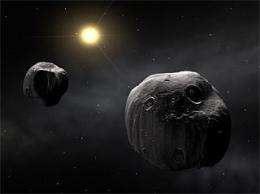Binary planetesimals

(PhysOrg.com) -- In fewer than ten million years, the material in the disk around a young star will either be accreted on to its star, dispersed into the interstellar medium, or converted into planets or smaller solid bodies. As the material in the disk orbits the star, each particle has a velocity that depends on its distance from the star.
Current models for the evolution of pre-planetary disks invoke three basic processes. In the first two, bodies interact with each other to exchange energy and alter their velocities and distances from the star. In the third, small orbiting clumps of coagulated dust grains stick to one another and grow into larger bodies, called planetesimals.
The solid bodies often sculpt gaps, or cavities, in the disk, by accreting more material; some grow into planets. Eventually winds from the star will sweep away the remaining disk material. Each of these processes is influenced by many factors that astronomers are working hard to understand.
In a new paper, CfA astronomer Hagai Perets studies the role of binary planetesimals -- clumps that orbit each other and jointly mature via the three basic processes. Do such binary planetesimals even exist? And how might they influence the development of the planetary system? For example, when two bodies interact the outcome is a relatively straightforward prediction, but a third body in the mix can make the interaction notoriously complex, even chaotic, for example possibly leading to one of the three bodies being ejected from the system.
Perets introduces a set of relatively simple theoretical arguments to illustrate how binary planetesimals might make a very big difference to the final planetary system. He first notes the existence in our solar system today of many such binaries, and argues that some of them could be remnants from earlier times. He shows that the role of binaries, ignored in most previous studies, is not only not negligible - it potentially plays an important role in the evolution of the planetary system and should not be ignored in future simulations and modeling.
Provided by Harvard-Smithsonian Center for Astrophysics

















